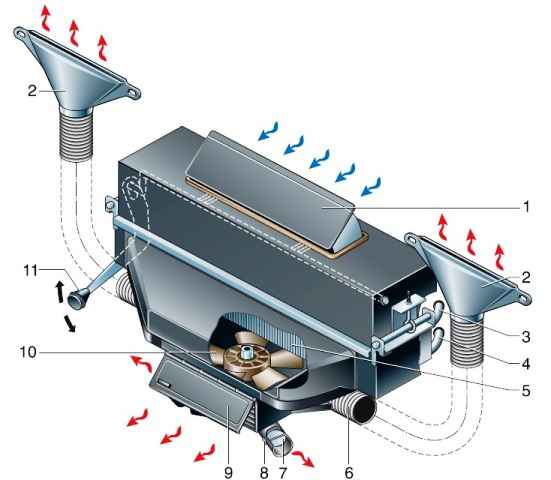The car has natural and forced ventilation
During natural ventilation, air enters the cab through the swing doors
During the movement of the car, the oncoming air flow additionally enters the cab through the air intake installed in front of the windshield

The air intake is opened by a lever mounted to the left of the heater.
In hot weather, to improve ventilation, you can remove the door glass along with the frames
With forced ventilation and closed windows, air is blown into the cab by the electric fan of the heater without heating
The air passes through the air intake, the disconnected heater core, the fan and exits to the driver's and front passenger's footwells, as well as the central part of the cab to the rear seats
In addition, through corrugated plastic hoses, air enters the windshield blower pipes. Air comes out through the gaps between the cabin elements
Rainwater, entering the heater body through the air intake, drains out through a rubber hose led into the engine compartment through a hole in its partition.
The cabin is heated with heated air, which is supplied, as with forced ventilation, but with the heater radiator turned on.
To regulate the flow of hot liquid from the engine cooling system to the heater radiator, a valve mounted on the cylinder head
When the tap is open, the liquid from the cylinder head enters the heater radiator and is discharged through the second pipe to the pump, forming a small circle of circulation parallel to the main flow of liquid in the cooling system
The intensity of heating and ventilation can be adjusted with the switch of the electric fan, choosing the mode of maximum or minimum rotational speed of its shaft, as well as adjusting the amount of lifting of the air intake hatch cover with the handle
If necessary, you can direct all the warm air to the windshield only
To do this, close the cover of the heater box and dampers on the lower air ducts
From operating experience
Of course, the UAZ stove is not a fountain.
Because the engine on these cars operates in completely different temperature conditions compared to VAZ cars. Therefore, you need to take this into account in the winter.
To achieve a comfortable temperature in the car, you need to shade the engine radiator and insulate both the engine compartment itself and the passenger compartment. Monitor the tightness of doorways, etc.
Recently, many UAZ car drivers have begun to install an additional electric pump on the small circle of the cooling system. Pretty good results. And of course, you need to check the condition of the stove radiator.
Many people think that their radiator is clogged. Although, upon opening and disassembling, it turned out that the radiator cells were simply clogged with leaves and dust from the outside.
It should not be forgotten that the coolant flows through the heater radiator in a small circle.
Forcing her to do so is the thermostat, which must be closed while the engine is warming up.
And if for some reason the thermostat was removed or does not work properly, then the proper temperature of the stove cannot be achieved.





